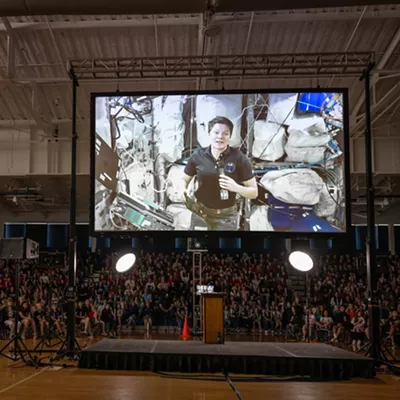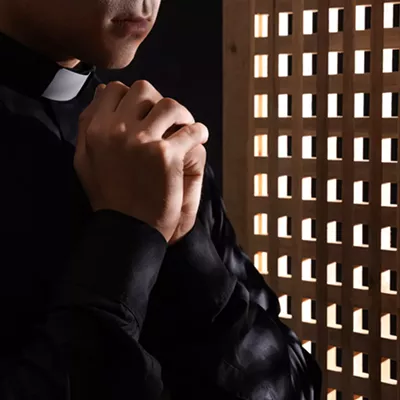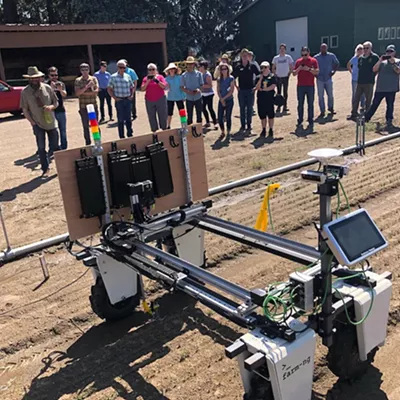Just prior to the election, it was certainly engrossing to see a play that brought up questions of intrigue, duplicity, blackmail and abuse in the higher echelons of our bureaucratic world.
Reminiscent of the Spy vs. Spy cartoon strip from years ago, Talking in Shadows shows us nefarious activities that may undermine our existence, whether they are government-driven, based on corruption in the corporate structure or coming from personal malevolence.
It was also nostalgic to be back at the Valley Rep Theatre. Still around -- not a mean feat these days with so much theatrical competition -- Valley Rep had a string of successes in Nunsense, Angry Housewives and I Never Saw Another Butterfly. After a hiatus, the theater has reemerged and is attempting to be a presence once again in our community.
The play, Talking in Shadows, was written by Warren Carlson of Sandpoint. Carlson has worked in theaters in Oregon, and he got his BA in creative writing from University of California, Santa Barbara. Carlson wrote for The Oregonian and has also written about Oregon history. He was a finalist in the 1994 Oregon Arts Commission Theater Arts award.
This play takes place in Washington, D.C., in 1960, and it kindles thoughts about how J. Edgar Hoover was trying to control the government from his office as FBI director. Events in the play also bring to mind the trial of Paul Robeson defending himself before the House, accused of unAmerican activity and the assassination of Martin Luther King Jr.
When the play opens, we are introduced to the troubled FBI man, Stacy Harrison (Jerome Gray) and his long-suffering wife Katherine (Lavada Hunter). The scenes with this FBI family are juxtaposed to the activities of the maniacal director of the FBI (Bill Hay) and his silly secretary, Veronica Castleman (Pam Stark).
But it took me several scenes to decide whether the director, Jodine Watson, was going for the jugular or for the camp side of the story. There were many moments (mostly by Hay) when I wasn't sure. In fact, I think Watson should have made a stronger conscious choice to have her actors stay focused on the serious side of the play, rather than veer into parody.
The character of Veronica (Stark) portrays the stereotypical, long suffering secretary who's having an affair with her boss. She is sincerely committed to him, regardless of his devious actions. Unfortunately, it seems that the director Watson misdirected the actress. Veronoica's very genuine moments are overshadowed by strange excursions into Betty Boop land.
Hay's Hoover had moments of dementia that verged on satire, rather than the realism, which I believe is the playwright's intention.
The other characters were very real, so the audience was left with a stylistic dichotomy. Hunter, as the agent's wife, did a very credible job, as did Bruce Arnold as the soundman.
But Gray and Scott Lockwood, the two FBI men caught between their sincere desire to be good Americans and the machinations of their boss, were not successful in their portrayals.
One directorial choice that could have been used more effectively was the spotlight to enhance moments of inner monologues to reveal internal struggles. At the end of the play, the FBI director delivers his 11th hour speech, clearly defining his misguided demagoguery. His moment in the hot spot was particularly chilling.
There are several good monologues throughout the play that scream out for this type of defining moment. A good directorial choice, if expanded, would have brought a more cohesive stylistic touch to the production.
For those of you not familiar with the Valley Rep, it has an odd layout. The stage area is almost an arena on a diagonal, which means the stage is shaped like a triangle with an expanded base. It is challenging for actors to play to such a panorama, and the technical person has to create a space that works across a very wide fourth wall (the imaginary barrier that separates the actor from the audience). Whoever did the set accomplished this with two locales: the Harrison home and the FBI director's office, with a surveillance location on a second level, upstage and behind the main stage area.
What I love about a theater like Valley Rep is that it fulfills a need in our community by providing a fringe theater where artists can experiment, spread their wings and hone their craft. Valley Rep takes that role seriously, and there is a core group with a strong dedication to keep it going.
















